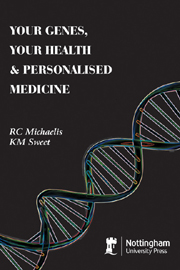Book contents
- Frontmatter
- Contents
- INTRODUCTION
- 1 UNDERSTANDING THE MEANS BY WHICH OUR GENES INFLUENCE OUR HEALTH
- 2 THE MECHANISM WHEREBY A GENE MAKES ITS PROTEIN
- 3 UNDERSTANDING THE PRINCIPLES OF INHERITANCE
- 4 USING YOUR FAMILY HISTORY INFORMATION TO PREDICT YOUR RISK FOR SPECIFIC DISEASES
- 5 USING GENETIC TESTING TO MAINTAIN YOUR HEALTH AND PERSONALISE YOUR MEDICAL CARE, NOW AND IN THE FUTURE
- 6 MAKING THE DECISION WHETHER OR NOT TO HAVE GENETIC TESTING, AND INTERPRETING THE RESULTS OF TESTS YOU CHOOSE TO HAVE PERFORMED
- 7 NUTRIGENOMICS AND EPIGENETICS: THE EFFECTS OUR DIET, ENVIRONMENT AND LIFESTYLE HAVE ON OUR GENES AND PROTEINS
- EPILOGUE AND USEFUL INTERNET RESOURCES
- INDEX
5 - USING GENETIC TESTING TO MAINTAIN YOUR HEALTH AND PERSONALISE YOUR MEDICAL CARE, NOW AND IN THE FUTURE
- Frontmatter
- Contents
- INTRODUCTION
- 1 UNDERSTANDING THE MEANS BY WHICH OUR GENES INFLUENCE OUR HEALTH
- 2 THE MECHANISM WHEREBY A GENE MAKES ITS PROTEIN
- 3 UNDERSTANDING THE PRINCIPLES OF INHERITANCE
- 4 USING YOUR FAMILY HISTORY INFORMATION TO PREDICT YOUR RISK FOR SPECIFIC DISEASES
- 5 USING GENETIC TESTING TO MAINTAIN YOUR HEALTH AND PERSONALISE YOUR MEDICAL CARE, NOW AND IN THE FUTURE
- 6 MAKING THE DECISION WHETHER OR NOT TO HAVE GENETIC TESTING, AND INTERPRETING THE RESULTS OF TESTS YOU CHOOSE TO HAVE PERFORMED
- 7 NUTRIGENOMICS AND EPIGENETICS: THE EFFECTS OUR DIET, ENVIRONMENT AND LIFESTYLE HAVE ON OUR GENES AND PROTEINS
- EPILOGUE AND USEFUL INTERNET RESOURCES
- INDEX
Summary
The Currently Available Genetic Tests Provide A Variety Of Specific Benefits
Genetic tests are capable of providing a wide assortment of benefits, but it is important to remember that all genetic tests have significant limitations. In Chapter 6 we discuss some of the issues that are involved in interpreting the results of genetic tests, and describe the limitations of the genetic tests that are currently available. In this chapter, we build upon the principles discussed in Chapters 1-4, to help you understand what tests are available now, and how these tests provide you information about the level of activity of important proteins.
Some Tests Help Estimate Your Risk For Diseases
One way in which genetic testing will be used to help improve health care is to provide tests that accurately estimate your risk for specific diseases. Researchers can identify one or more places in the gene's sequence where the specific version of the sequence that the person possesses affects the protein's level of activity. A test can then be designed to determine whether the version(s) of the gene that a given person has increase or decrease his/her risk for the corresponding disease. These predictive tests can take one of two forms:
There are a number of single-gene diseases (see Table III-1 for examples) for which predictive genetic tests are available.
Some genetic tests help estimate your risk for specific multifactorial diseases.
- Type
- Chapter
- Information
- Your Genes, Your Health and Personalised Medicine , pp. 87 - 106Publisher: Nottingham University PressPrint publication year: 2011



